Lily of the Valley is a beautiful perennial plant renowned for its unique bell-shaped flowers and enchanting fragrance.
It holds rich significance and value in various domains such as horticulture, medicine, culture, ecology, history, and cultivation methods.
Below is a detailed introduction to Lily of the Valley from these six aspects:
1. Horticultural Value
Lily of the Valley is a popular garden plant, widely cultivated for its attractive appearance and pleasant aroma. Its small, delicate, bell-shaped flowers usually bloom in spring, with white petals symbolizing purity and tranquility.
The plant's leaves are also appealing, being oval-shaped and bright green, adding a fresh touch to gardens. Due to its low requirements for growing conditions and strong adaptability, Lily of the Valley thrives in cool, moist environments, making it an excellent ground cover plant, especially suitable for planting under trees or along garden edges.
2. Medicinal Value
In addition to its high ornamental value, Lily of the Valley also has significant medicinal properties. The entire plant contains cardiac glycosides, particularly in its roots and flowers, which have notable cardiotonic effects.
In traditional herbal medicine, Lily of the Valley has been used to treat conditions such as heart failure, arrhythmia, and angina. Its extracts possess diuretic, sedative, and anti-inflammatory properties. However, due to its high toxicity, it must be used with caution, especially in dosage control, to avoid poisoning.
3. Cultural Symbolism
Lily of the Valley symbolizes different meanings in various cultures.
In Europe, it symbolizes the return of happiness, and in many countries, it represents good luck and joy. In France, May 1st is known as "Lily of the Valley Day," where people exchange flowers to express best wishes. In the UK and the US, Lily of the Valley is often used in wedding decorations, symbolizing the bride's purity and happiness.
4. Ecological Value
Lily of the Valley plays an important role in the ecosystem. As a perennial plant, it spreads through underground rhizomes, and its root system effectively prevents soil erosion and protects soil structure.
Additionally, its fragrant flowers and nectar attract many insects, including bees and butterflies, aiding in pollination and promoting biodiversity. The plant’s leaves and stems provide shelter for small animals, making it an indispensable part of ecological balance.
5. Historical Origins
The cultivation history of Lily of the Valley dates back to ancient Rome, where it was considered a precious medicinal plant.
During the Middle Ages, Europeans often planted Lily of the Valley to make herbal remedies and treat ailments. In the 19th-century Victorian era, it became a popular garden plant, favored by the nobility and upper society, symbolizing purity and elegance.
6. Cultivation and Care
Lily of the Valley is relatively easy to cultivate and maintain, making it suitable for beginners. It prefers cool, moist environments, and the best planting time is in autumn or early spring. When planting, choose a semi-shaded or fully shaded area with well-drained, organically rich soil.
The plant primarily propagates through division, usually done after flowering. The rhizomes are separated and replanted. Lily of the Valley does not require much fertilizer; an annual application of organic fertilizer in spring is sufficient. It is hardy against cold weather, but in extremely cold regions, some protective covering during winter is advisable to prevent frost damage.
Lily of the Valley is cherished not only for its beautiful appearance and fragrant smell but also for its significant value in medicine, culture, and ecology. Understanding its multifaceted characteristics allows us to better appreciate and protect this precious plant. In modern gardening and nature conservation, Lily of the Valley continues to play an irreplaceable role.
Through scientific cultivation and care methods, we can enable Lily of the Valley to thrive in more areas, enriching the environment and bringing more happiness and health to people.


